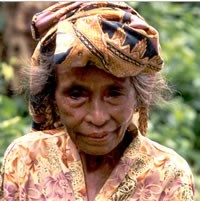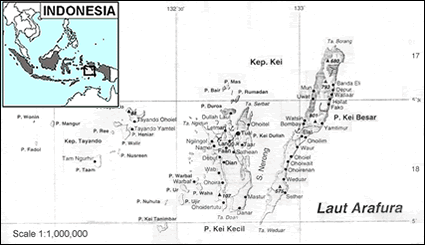Indonesia is the fourth most populous nation in the world and continues to grow rapidly. It has one of the most ethnically diverse populations in the world, with more than 750 distinct people groups, many of whom are Muslim. Located in southeastern Asia, the islands of Indonesia serve as vital sea routes between Australia, Europe, and the Asian mainland. They are the principal link between the Pacific and Indian Oceans.
The Kei Islands, a part of Indonesia, are a small group of islands located in the Banda Sea between Irian Jaya and Australia. The inhabitants of these islands are called the Kei (or Tanimbarese), and their language is also called Kei. Although their physical features resemble those of the people of Papua New Guinea, the Kei islanders are of a very mixed ancestry. They were introduced to Islam as early as the fifteenth century, and later during Dutch rule, Christianity was brought to the islands.
Fishing is the main livelihood of the Kei villagers. The people go out, usually at night, in plank boats or in dugout canoes. They use spears, harpoons, hooks, and traps to catch the fish.
The Kei also engage in some farming, using the slash and burn technique. In this type of agriculture, the land is first cleared by burning the existing vegetation. Then, in the resulting fertile top soil, the crop is planted. After a year or two on the land, the farmer moves to a new area and begins the process all over again. Using this method, the Kei cultivate taro (a potato-like vegetable), yams, maize, and rice. They also collect sago (a powdery starch obtained from the trunks of sago palms) from the swamps. For export and cash, the people make boats and canoes, cut timber, and produce copra (dried coconut meat yielding coconut oil).
Formerly, settlements were built on the tops of high, steep rocks or hills for protection. They were usually grouped in dense clusters of 20 to 50 houses, surrounded by a stone wall. Today, the houses lack any one type of distinctive style, apart from being built on stilts.
The most important group in the Kei village is the fam (group with a common male ancestry). Some fams are small, with their members living in a few villages close together. Other fams are very large, with their members living in many villages spread over a broad area. A village may also contain members of several fams. However, one fam is usually regarded as being the senior fam. Its members are the direct descendants of those who first settled the village.
The ideal marriage to the Kei is a cross-cousin marriage. The man will usually pay a bride-price, and this will be reciprocated by a gift from the girl's relatives. To avoid a large bride-price, the man may practice bride-service instead. In this case, he will live and work for his wife's parents for a number of years.
Traditional Kei culture recognizes three social classes: the village heads, the ordinary people, and the slave class. The members of the ruling lineage of village heads are called the mel mel, and many of these claim foreign descent. The village head is called the rat or orang kaja.
The Kei are primarily ethnic religionists, practicing their ancient traditions and religions. An important element in their religion is the belief in spirits of the dead. The spirits of those who died a violent death or of women who died in childbirth are especially feared. Mythology also speaks of Duan Lerwuan, the god of the sun, and of Duan Luteh, the god of the moon. Other Kei deities include Hejan Suwat, the god of the sea, and Lir Majoran, the god of agriculture.
While the Kei have a history of evangelization to some degree, there has been little response, and today, very few are Christians. Evangelistic literature and Christian media are needed if the Kei are to come to a saving knowledge of Jesus Christ.
Ask the Holy Spirit to grant wisdom and favor to any missions agencies focusing on the Kei of Indonesia.
Pray that God will give Kei believers boldness to share Christ with their own people.
Ask God to raise up prayer teams who will begin breaking up the soil through worship and intercession.
Ask the Lord to bring forth a vigorous Kei church for the glory of His name!
Scripture Prayers for the Kei, Tanimbarese in Indonesia.
| Profile Source: Bethany World Prayer Center |











